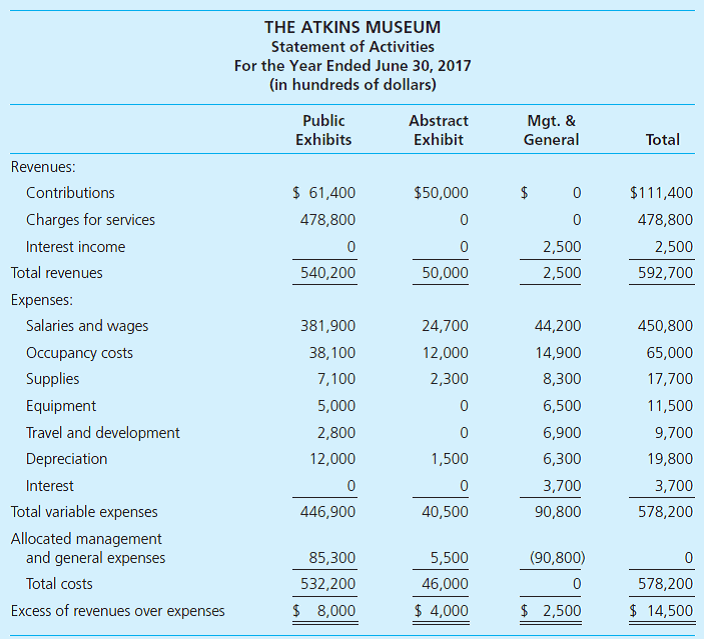Cost Concept Of Accounting
Content

These services do not include centralized services included in central service cost allocation plans as described in Appendix V to Part 200. Any non-Federal entity that has a current federally-negotiated indirect cost rate may apply for a one-time extension of the rates in that agreement for a period of up to four years.
- The total cost of a Federal award is the sum of the allowable direct and allocable indirect costs less any applicable credits.
- You can consent to processing for these purposes configuring your preferences below.
- Financial investments that your business makes should also be recorded at fair market value and adjusted after each accounting period to reflect the most current value.
- The first cost principle accounting example is the Google acquisition of YouTube.
It also includes architect-engineer contracts related to construction projects. It does not include contracts for vessels, aircraft, or other kinds of personal property. Weighted average cost means an inventory costing method under which an average unit cost is computed periodically by dividing the sum of the cost of beginning inventory plus the cost of acquisitions by the total number of units included in these two categories.
Cost Principles, Hrs Chapter 103f, Purchases Of Health And Human Services
When the allocation method is used, separate allocations must be made to selective groupings of employees, unless the non-Federal entity demonstrates that costs in relationship to salaries and wages do not differ significantly for different groups of employees. The total cost of a Federal award is the sum of the allowable cost principle direct and allocable indirect costs less any applicable credits. Both activities and transactions could be considered unallowable due to regulations put in place by the federal government or other sponsor. Unallowable costs may also be identified in the specific terms and conditions of a sponsored project.

Under the cost principle, long-term assets are recorded at historical cost and depreciated as the items age or the company uses up the value of the asset. This usage is recorded as depreciation on the accounting ledgers; original long-term asset values are netted against the total depreciation to determine the asset’s salvage value. The cost principle uses an asset’s salvage value as the future market value of the item. When a company sells long-term assets, any monetary difference above or below the salvage value is recognized as a gain or loss on the company’s accounting books. Balance sheet liabilities are recorded in a similar fashion using this principle.
What Is The Historical Cost Principle?
The cost of services provided by one agency to another within the governmental unit may include allowable direct costs of the service plus a pro-rated share of indirect costs. A standard indirect cost allowance equal to ten percent of the direct salary and wage cost of providing the service may be used in lieu of determining the actual indirect costs of the service.
Make Polluters Pay: How public education and advocacy revived the polluter pays principle – State PIRGs
Make Polluters Pay: How public education and advocacy revived the polluter pays principle.
Posted: Fri, 05 Nov 2021 07:00:00 GMT [source]
Scott should record the newly purchased asset at the cost he paid to purchase the copyright. Because copyright is an intangible asset, the copyright cost should be amortized, rather than depreciated. This is because, in many cases, the cost of an item is subjective and dependent on market conditions. For example, an asset you purchased a year ago may suddenly gain value for a variety of reasons. Maybe the manufacturer stopped making that particular item, or the item has become scarce.
No adjustments are made to reflect fluctuations in the market or changes resulting from inflationary fluctuations. The historical cost principle forms the foundation for an ongoing trade-off between usefulness and reliability of an asset. Examples of such assets include cash, government securities, and amounts to be received from debtors. This is because, for these assets, their present values are practically identical to their acquisition cost. Notably, since assets are recorded at the cost of acquisition, any future increase or decrease in their values is not recorded in the balance sheet. However, an exception to this rule is the diminution in value that may arise from the depreciation of assets.
Contracts with State, local, and federally recognized Indian tribal governments. Material-price standard means a preestablished measure, expressed in monetary terms, of the price of material. Material cost at standard means a preestablished measure of the material elements of cost, computed by multiplying material-price standard by material-quantity standard. Labor-time standard means a preestablished measure, expressed in temporal terms, of the quantity of labor.
The Historical Cost Principle Guidance
Over the last five years, the Brazilian currency has been in double-digit inflation and the investment is not worth nearly what Bill paid for it. The historical cost principle does not adjust asset values based on currency fluctuations, so the property would still be reported as the original purchase price. The historical cost principle is a trade off between reliability and usefulness. Knowing that a company purchased a piece of land in 1950 for $10,000 does not really tell financial statement users how much the land is currently worth. Re-valuing financial securities occurs at specific intervals during the accounting cycle; companies must write off or increase the value of these financial instruments. Mark-to-market accounting creates a significant change in the cost principle of accounting.
‘One China Principle’ being offered to Marshall Islands, worrying U.S. officials – KXXV News Channel 25
‘One China Principle’ being offered to Marshall Islands, worrying U.S. officials.
Posted: Sun, 28 Nov 2021 05:26:15 GMT [source]
The fiscal year will normally be 12 months, but a different period may be appropriate (e.g., when a change in fiscal year occurs due to a business combination or other circumstances). No final cost objective shall have allocated to it as a direct cost any cost, if other costs incurred for the same purpose in like circumstances have been included in any indirect cost pool to be allocated to that or any other final cost objective. All costs specifically identified with other final cost objectives of the contractor are direct costs of those cost objectives and are not to be charged to the contract directly or indirectly. Certain cost principles in this subpart incorporate the measurement, assignment, and allocability rules of selected CAS and limit the allowability of costs to the amounts determined using the criteria in those selected standards. Only those CAS or portions of standards specifically made applicable by the cost principles in this subpart are mandatory unless the contract is CAS-covered . Business units that are not otherwise subject to these standards under a CAS clause are subject to the selected standards only for the purpose of determining allowability of costs on Government contracts.
Since certain costs, such as administrative salaries and office supplies, are normally treated as F&A costs, these costs cannot be charged directly to federal Awards unless the circumstances of an Award are clearly different from the normal operations of the unit. Any highly liquid assets you purchase should be recorded at fair market value rather than historical cost. Financial investments that your business makes should also be recorded at fair market value and adjusted after each accounting period to reflect the most current value. In opposition to the advantages, the cost principle may sometimes present two major drawbacks.
However, a reasonable charge for using fully depreciated property may be agreed upon and allowed (but, see 31.109). In determining the charge, consideration shall be given to cost, total estimated useful life at the time of negotiations, effect of any increased maintenance charges or decreased efficiency due to age, and the amount of depreciation previously charged to Government contracts or subcontracts. Payments to union employees for the difference in their past and current wage rates for working without a contract or labor agreement during labor management negotiation are allowable. A cost is reasonable if, in its nature and amount, it does not exceed that which would be incurred by a prudent person in the conduct of competitive business. Reasonableness of specific costs must be examined with particular care in connection with firms or their separate divisions that may not be subject to effective competitive restraints. No presumption of reasonableness shall be attached to the incurrence of costs by a contractor. If an initial review of the facts results in a challenge of a specific cost by the contracting officer or the contracting officer’s representative, the burden of proof shall be upon the contractor to establish that such cost is reasonable.
Historical Cost Principle: How It Works & Why It Matters
Any lobbying made unallowable by paragraph of this subsection to influence state or local legislation in order to directly reduce contract cost, or to avoid material impairment of the contractor’s authority to perform the contract. No costs of current IR&D programs are allocated to Government work except to prorate the costs of developing a specific product to the sales of that product. Costs of idle facilities or idle capacity means costs such as maintenance, repair, housing, rent, and other related costs; e.g., property taxes, insurance, and depreciation.
- Distribute to all affected Federal awarding agencies any DS-2 determination of adequacy or noncompliance.
- The non-Federal entity may be compensated for the use of its buildings, capital improvements, equipment, and software projects capitalized in accordance with GAAP, provided that they are used, needed in the non-Federal entity’s activities, and properly allocated to Federal awards.
- However, application of cost principles to fixed-price contracts and subcontracts shall not be construed as a requirement to negotiate agreements on individual elements of cost in arriving at agreement on the total price.
- Any costs to be paid directly by the Government for idle facilities or idle capacity reserved for defense mobilization production shall be the subject of a separate agreement.
- Costs allowed for business interruption or other similar insurance must exclude coverage of management fees.
If the proportions cannot be easily determined, the cost may be allocable to the projects or programs receiving the benefit on any reasonable documented basis. Despite this, historical cost continues to be used as a basis for preparing primary financial statements. However, under the cost concept, the accounting records will continue to show the value of the building at the cost price of $100,000 less depreciation.
Disadvantages Of Cost Principle
Because they are so important to your business, it’s essential to record and report their value accurately and consistently, a relatively easy process if you’re using accounting software. Applicant Tracking Choosing the best applicant tracking system is crucial to having a smooth recruitment process that saves you time and money. Appointment Scheduling Taking into consideration things such as user-friendliness and customizability, we’ve rounded up our 10 favorite appointment schedulers, fit for a variety of business needs. Business Checking Accounts Business checking accounts are an essential tool for managing company funds, but finding the right one can be a little daunting, especially with new options cropping up all the time. CMS A content management system software allows you to publish content, create a user-friendly web experience, and manage your audience lifecycle. Construction Management This guide will help you find some of the best construction software platforms out there, and provide everything you need to know about which solutions are best suited for your business. Financial investments should be recorded at fair value at the end of each accounting period.
- F&A cost pools must be distributed to benefitted cost objectives on bases that will produce an equitable result in consideration of relative benefits derived., and set forth allowability and allocability principles for selected items of cost.
- A Federal awarding agency may use a rate different from the negotiated rate for a class of Federal awards or a single Federal award only when required by Federal statute or regulation, or when approved by a Federal awarding agency head or delegate based on documented justification as described in paragraph of this section.
- When a schedule of predetermined use rates for construction equipment is used to determine direct costs, all costs of equipment that are included in the cost allowances provided by the schedule shall be identified and eliminated from the contractor’s other direct and indirect costs charged to the contract.
- Labor cost at standard means a preestablished measure of the labor element of cost, computed by multiplying labor-rate standard by labor-time standard.
- They arise also in instances where the contractor requires similar assurance.
- This is because, in many cases, the cost of an item is subjective and dependent on market conditions.
When the contractor has an arrangement authorizing an employee association to provide or operate a service, such as vending machines in the contractor’s plant, and retain the profits, such profits shall be treated in the same manner as if the contractor were providing the service (but see paragraph of this subsection). Losses from operating food and dormitory services are allowable only if the contractor’s objective is to operate such services on a break-even basis. If it is determined that the terms of the capital lease have been significantly affected by the fact that the lessee and lessor are related, depreciation charges are not allowable in excess of those that would have occurred if the lease contained terms consistent with those found in a lease between unrelated parties. The estimated facilities capital cost of money is specifically identified and proposed in cost proposals relating to the contract under which the cost is to be claimed. If the contractor has intermediate home offices or segments that report directly to the contractor’s headquarters, the five most highly compensated employees in management positions at each such intermediate home office or segment. The Government shall receive an equitable share of any amount of previously funded PRB costs which revert or inure to the contractor.
When initial costs are included in the settlement proposal as a direct charge, such costs shall not also be included in overhead. Initial costs attributable to only one contract shall not be allocated to other contracts. Despite all reasonable efforts by the contractor, costs which cannot be discontinued immediately after the effective date of termination are generally allowable.
However, many financial experts argue that historical cost may be too conservative a value for assets because the sum is not adjusted even in stable market conditions. Using the historical cost principle is not only good accounting, but is a standard for public companies . In the U.S., the Financial Accounting Standards Board has set standards, called Generally Accepted Accounting Procedures , requiring the use of the historical cost principle. The International Financial Reporting Standards Board sets similar standards for international companies.
Costs that can be identified specifically with a particular sponsored award, an instructional activity, or any other institutional activity, or that can be directly assigned to such activities relatively easily with a high degree of accuracy. Costs incurred for the same purpose in like circumstances must be treated consistently as either direct or indirect costs. Where an institution treats a particular type of cost as a direct cost of sponsored awards, all costs incurred for the same purpose in like circumstances shall be treated as direct costs of all other activities of the institution.

The negotiation memorandum will state the circumstances pertaining to the case and the reason for accepting the deferred costs. Gains and losses of any nature arising from the sale or exchange of capital assets other than depreciable property shall be excluded in computing contract costs.
These tests also apply regardless of treatment as a direct cost Costs that can be identified specifically with a particular sponsored project, an instructional activity, or any other institutional activity, or that can be directly assigned to such activities relatively easily with a high degree of accuracy. Or an F&A cost Necessary costs incurred by a recipient for a common or joint purpose benefitting more than one cost objective, and not readily assignable to the cost objectives specifically benefitted, without effort disproportionate to the results achieved. F&A cost pools must be distributed to benefitted cost objectives on bases that will produce an equitable result in consideration of relative benefits derived.. The fact that a proposed cost is awarded as requested by an applicant does not indicate a determination of allowability. Costs may be charged as either direct costs Costs that can be identified specifically with a particular sponsored project, an instructional activity, or any other institutional activity, or that can be directly assigned to such activities relatively easily with a high degree of accuracy. Or F&A costs Necessary costs incurred by a recipient for a common or joint purpose benefitting more than one cost objective, and not readily assignable to the cost objectives specifically benefitted, without effort disproportionate to the results achieved. For contracts other than those subject to paragraph of this section, the base period for allocating indirect costs shall be the contractor’s fiscal year used for financial reporting purposes in accordance with generally accepted accounting principles.

Cost of idle facilities or idle capacity means costs such as maintenance, repair, housing, rent, and other related costs, e.g., insurance, interest, and depreciation. These costs could include the costs of idle public safety emergency facilities, telecommunications, or information technology system capacity that is built to withstand major fluctuations in load, e.g., consolidated data centers. Costs of other general types of government services normally provided to the general public, such as fire and police, unless provided for as a direct cost under a program statute or regulation. Gains and losses on the sale, retirement, or other disposition of depreciable property must be included in the year in which they occur as credits or charges to the asset cost grouping in which the property was included. The amount of the gain or loss to be included as a credit or charge to the appropriate asset cost grouping is the difference between the amount realized on the property and the undepreciated basis of the property. If the non-Federal entity is instructed by the Federal awarding agency to otherwise dispose of or transfer the equipment the costs of such disposal or transfer are allowable.
Author: Christopher T Kosty
